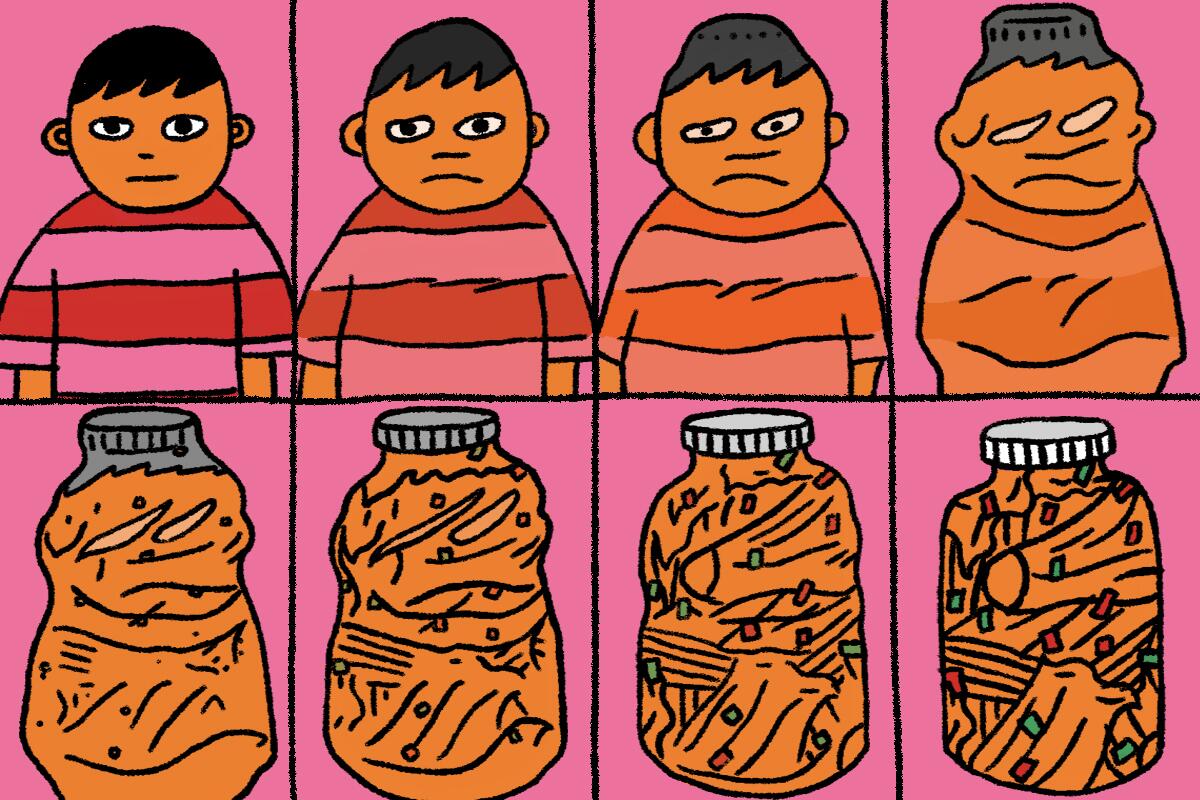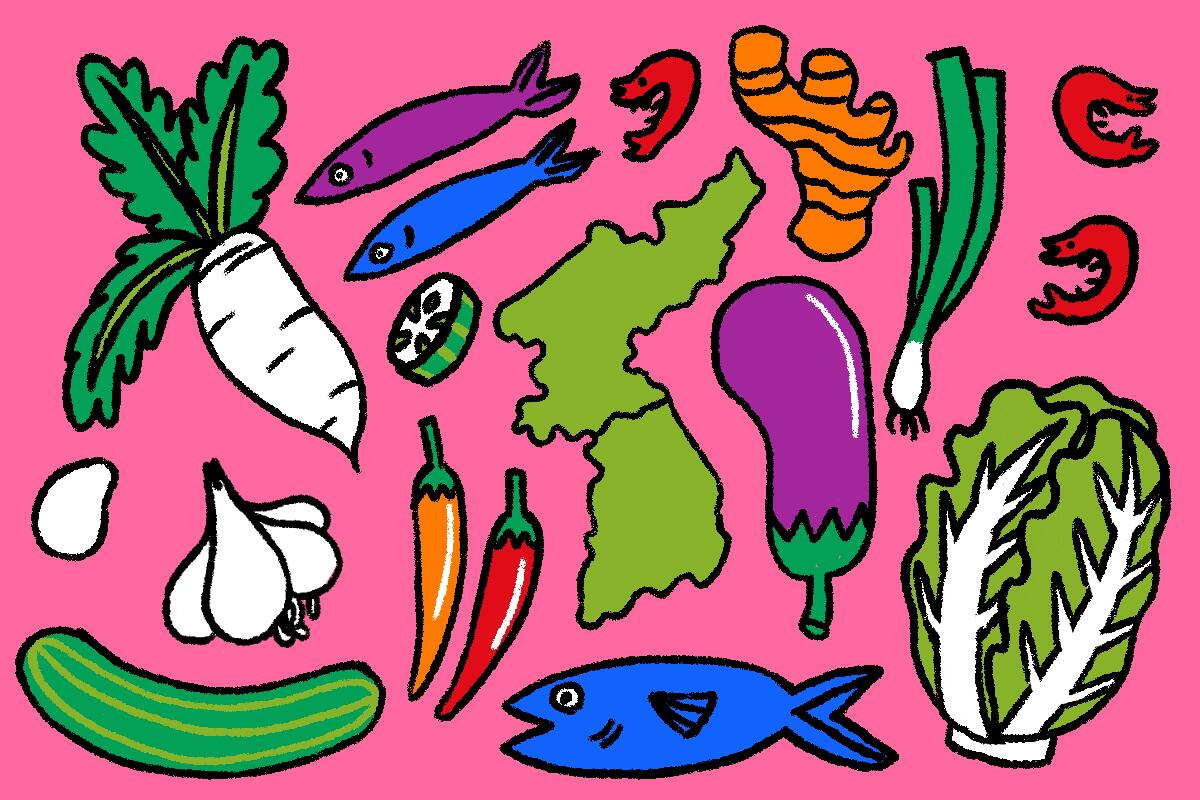Newsletter
Eat your way across L.A.
Get our weekly Tasting Notes newsletter for reviews, news and more.
You may occasionally receive promotional content from the Los Angeles Times.

Several years ago on a drive home with my mom, my physical being and existence came into question when an unsecured jar of tongbaechu kimchi in the back of her 1995 Chevrolet Astro van was jostled loose by an abrupt stop.
The gallon-sized glass jar, packed tightly with whole napa cabbage kimchi and all its juices, ricocheted off the back of the van and was sent barreling through a gantlet of rear-row seats, before shattering at the base of the center console.
I was 10 and prone to learning things the hard way, so I rushed to save the kimchi. My hand reached for the heap of cabbage, red pepper flakes and fermented salted shrimp. Instead, my right thumb met the sharp edge of a broken shard of glass.
My blood ran thick, dark and red. It mixed with the sanguine flow of the fermented mass. When I sucked the blood from the wound, I tasted only kimchi, and in my anxiety-addled mind, I wondered: “How much of me is me, and how much of me is kimchi?”

Kimchi and other iconic foods can have that effect on a person. These are the beloved dishes that have been exalted to such a degree that they can be as much a part of a collective identity as they are a part of a diet. They are extensions of ourselves and our communities — shared treasures that imbue the type of cultural and national spirit usually saved for the World Cup or Olympics.
They also have history.
The timeline of kimchi is marked by pain and prosperity — the story of the Korean peninsula and its people. For kin carried away by diasporic waves, kimchi serves as an ever-glowing beacon, ready to welcome daughters and sons home.
::
A keystone of the Korean diet, kimchi is an unmistakable star that rarely commands the spotlight and is instead relegated to side-dish status. But its absence is always glaring.
“If I run out of kimchi, I’m lost,” said Emily Kim, better known to just about anyone who has ever searched online for a Korean recipe as Maangchi. For 13 years, Kim has helped bring Korean cooking into countless home kitchens through her cookbooks and her popular YouTube channel, Cooking Korean Food With Maangchi, which has nearly 5 million subscribers.
On days she prefers to keep it simple at home in the kitchen, Kim sticks to the basics: kimchi, rice and soup.
“Sometimes, depending on my mood, I’d make more protein, like bulgogi,” Kim said. But kimchi is the linchpin of her meals. “Even if I have meat and I can make bulgogi, if I don’t have kimchi, I’m like, ‘What should I eat?’”
Making kimchi is easy, and there’s perhaps no teacher who’s more accessible and better than Maangchi.
Such is the fervent faith many Koreans have in their culture’s iconic dish. There’s a willingness to believe kimchi can save — be it a meal or the spirit — because it has come through so many times before.
“As long as I have kimchi in my refrigerator, I don’t worry much,” said Kim.

::
Kimchi was born out of necessity, in the darkness and cold of the Korean winter.
From the north, a semi-permanent pressure system builds its might over the Siberian tundra before sweeping its cold, dry winds across the land. In pre-modern Korea, fresh vegetables and the nutrition they provided were hard to come by during the long winter. And so, like many peoples around the world faced with scarce food resources, early Koreans turned to preservation.
In Goryeo, an ancient Korean kingdom that once controlled the entire peninsula, fermentation was the method of choice. The first records of kimchi and Korean fermentation prowess appear in “Records of the Three Kingdoms,” a 3rd-century Chinese historical text: “The [Goryeo] people are very good in making fermented foods such as wine, soybean paste and salted and fermented fish.”
An incomprehensive but indisputably correct guide to the great kimchis of Los Angeles.
Early kimchi was heavily influenced by Buddhism and the practice of abstaining from meat. At the time, cabbage wasn’t the popular base ingredient used in kimchi-making as it is today, and red chile peppers wouldn’t be introduced for centuries. Instead, wild herbs and cultivated vegetables such as turnips, eggplants and bamboo shoots were turned into kimchi by salting them or dipping them into a paste, vinegar or grain gruel to allow them to ferment. To add color, violet-tinged leaf mustard, cockscomb and safflower were sometimes used.
Kimchi went through a renaissance during the reign of the Joseon kingdom, the last Korean dynasty, which lasted from 1392 to 1897 and included a period wrought by invaders from China and Japan, as well as an extended isolation. But it was also bookended by periods of extraordinary growth.
Typography improved, allowing more efficient farming methods to be shared widely. Advancements in agriculture and an unprecedented growth in trade brought in new produce and ingredients. It was during the Joseon period that napa cabbage and white radishes became the primary ingredients in kimchi, and gochugaru (red chile pepper) — now a must-have Korean pantry item — was introduced.

::
As kimchi began to develop into a staple, unique styles also began to emerge. Access to resources and weather variations led to distinct methods of preparation across the peninsula.
Seoul and the surrounding area make up modern Gyeonggi-do, a province that once included parts of North Korea, including Kaesong, before the country was torn in two by the Korean War. Kimchi here tends to be mild, with kimchi makers eschewing large portions or heavily salted or spiced ingredients in their pursuit of lighter, more subtle flavors. Historically, Gyeonggi-do has been the seat of power and many of the royal culinary traditions, which produced elaborate and ornate kimchis, were shared throughout the region.
In Jeollanam-do, a province located at the southwestern tip of South Korea, the warmer weather accelerates fermentation. To help control the process, kimchi here is lathered thick with gochugaru and pickled seafood — a benefit of having an abundant seafood supply — before it’s stored for fermentation. The end result is strong and pungent kimchi.
“In Seoul, instead of heavy fish, they used fermented shrimp and not too much heavy kimchi paste,” said Kim, who was raised in Yeosu, the largest city in Jeollanam-do. She now lives in New York City but still imports whole salted and fermented anchovies from Korea. “The kimchi is very famous. Even Seoul people love our kimchi.”
Some of these kimchi facts are out of this world.
Around Pyongyang to the north, it’s the polar opposite. The cold weather slows down the fermentation process, which still must be closely monitored, and fewer spices and salted ingredients are needed. The kimchi tends to be lighter and noted for its refreshing quality. Dongchimi, a popular water-type kimchi made with daikon radishes, can be enjoyed on its own, but its cold and briny broth is often used for another famous North Korean dish, naengmyeon (cold buckwheat noodles).
::
With kimchi becoming a fixture of the Korean diet, its making took on greater prominence in the daily lives of Koreans. For families and communities, making enough kimchi to last the winter was just as much about preserving a way of life as it was about preserving cabbages and radishes.
Kimjang is the traditional kimchi-making progress that includes fermenting seafood in the spring and grinding the summer’s red chile peppers into gochugaru. But it more specifically and generally refers to the period in late fall when families gather to turn hundreds of heads of napa cabbage into about three months’ worth of kimchi.
In many communities and neighborhoods, kimjang is still a time to come together for the collective good. It’s almost always the women of Korean households who band together to make enough kimchi for their families and one another — more than they ever could make on their own. Ad-hoc kimchi-making enterprises spring up each November. Assembly lines are formed: napa cabbages are trimmed, cleaned and salted; garlic and ginger are peeled and cut, ready to be mixed with gochugaru and saeu-jeot (salted fermented shrimp) for the sok, or kimchi paste; deft hands lather the spicy and pungent mixture in between each leaf of every cabbage.
“Kimjang is a way to rely on your friend,” said Kim, whose mother would purchase 200 heads of cabbage that would be delivered by cart to their home. “Kimjang is special because during the winter time, it’s going to be responsible for my family’s health.”
Traditionally, fully prepared kimchi is placed into Korean earthenware jars, or onggi, that are made of clay. Onggi have microscopic pores that allow the jar to “breathe,” letting air circulate inside to aid the fermentation process.
During winter, kimchi-stuffed jars are buried underground or stored away from the elements, waiting to be unearthed in the spring. Some kimchis are prepared based on when they are expected to be freed from the ground and consumed. In warmer months, summer kimchis in onggi can be placed in running water to maintain a cool temperature.
As South Korea has modernized and urbanized, fewer people use onggi to store and ferment their kimchi, opting for plastic or glass containers, or modern kimchi refrigerators specifically designed to regulate temperature and air flow to aid fermentation.
“Bread-making, cheese-making — all these things are processes that require you to do work, but it’s the bacteria and yeast that are also doing their work and magic,” said L.A.-based Hae Jung Cho, who leads virtual kimchi-making classes. “It takes time and then you have to see how it turns out. So there’s this element of surprise and wonder. Not everything is within your control and I kind of like that — to see how it turns out.”
::
Although modern kimchi production has allowed grocery stores to stock their shelves with ready-to-eat kimchi year-round, kimjang remains a vital part of Korean culture. From the way mothers, grandmothers and aunts would squat on their haunches while making kimchi to the oversized bowls and gloves they would use, the fine details are seared into the memories of many Koreans.
Haejung Kim, an L.A.-based florist who also leads kimchi-making workshops, moved to the United States from South Korea when she was 5. Every summer, she visited her grandparents at their farm in Cheongpyeong, just east of Seoul, but would miss kimjang season in November. It wasn’t until she got to study abroad and spent an entire year there that she was able to see it for the first time at the farm.
“My grandparents have this two-story house at a farm, and in front is a giant green lawn with a huge magnolia tree with a wooden platform underneath. We’re all on that lawn by the magnolia tree and my aunts are kimchi-squatting with those huge metal tubs,” she said. “Kimjang fits into that culture of women sitting around the kitchen, talking, chatting and making food together. That’s definitely a scene that I love.”
Even abroad, kimjang has retained its cultural significance in Korean households and communities.
Chef Chris Oh was born in South Korea but raised in Cupertino. He vividly remembers the “kimchi parties” his mother hosted.
“Her friends would come over and they would sit on the kitchen floor,” Oh said. “I can specifically remember the pattern of the floor because they would do it all the time. It was this cream-and-brown-pattern linoleum floor and they would just be squatting down there with their pink gloves that would come all the way to the elbow. They would sit around the tub like a campfire and make kimchi.”
Oh’s parents worked long hours at a dry cleaner. They were strict, he said, but their spirits would be lifted whenever kimchi was being made.
“You kind of saw the human side of them, the normal side of them where they would be able to socialize and have fun and have laughs. Like whoa, these are my parents? It was crazy because they’re doing all these crazy cool Korean traditions in this home in Cupertino, Calif., and not in Seoul, Korea,” he said.
“Looking back on it, my parents, like a lot of other parents, are the first generations of Koreans to come and take that gamble and move to the States. With any kind of huge move, you’re going to gravitate toward your own kind, your own people, your own culture. Back then, it must’ve been tough. So yeah, that sense of comfort I bet was far and few back then.”
There is no template for the Korean experience.
As a chef, Oh has helped amplify that sense of Korean comfort. He’s opened a handful of restaurants in L.A. and Hawaii, and last year he was able to open his first in the Bay Area with Um.ma in San Francisco’s Inner Sunset. Umma is the Korean word for “mom” and the restaurant is his tribute to his mother and others.
“Your mom’s cooking is always best. It’s so comforting and nostalgic,” he said.
At Um.ma, Oh had to take kimchi jjigae (stew) off his menu, he said, because everyone had an opinion on how to do it right — the way their own mothers made it. “It’s like a fingerprint. There’s no one kimchi jjigae alike,” he said.
“Whether we’re born here or Korea, we grew up to be such a prideful community and culture and I really feel like kimchi is that glue. Kimchi is almost like our security blanket,” Oh said. “Whether you’re in another country or if you’re broke and you’re poor and all you can eat is kimchi and rice, it’s still that sense of security and comfort that every culture, every person needs. It just so happens we get to eat ours.”
Eat your way across L.A.
Get our weekly Tasting Notes newsletter for reviews, news and more.
You may occasionally receive promotional content from the Los Angeles Times.